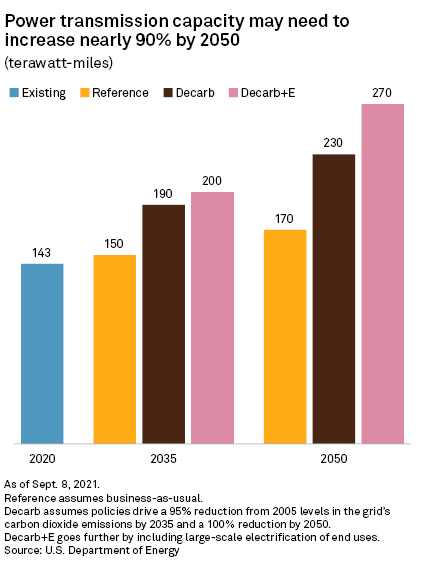Featured Topics
Featured Products
Events
S&P Global Offerings
Featured Topics
Featured Products
Events
S&P Global Offerings
Featured Topics
Featured Products
Events
S&P Global Offerings
Featured Topics
Featured Products
Events
Financial and Market intelligence
Fundamental & Alternative Datasets
Government & Defense
Banking & Capital Markets
Economy & Finance
Energy Transition & Sustainability
Technology & Innovation
Podcasts & Newsletters
Financial and Market intelligence
Fundamental & Alternative Datasets
Government & Defense
Banking & Capital Markets
Economy & Finance
Energy Transition & Sustainability
Technology & Innovation
Podcasts & Newsletters
28 Oct, 2021

| The Federal Energy Regulatory Commission is considering sweeping changes to its electric transmission policies. Source: aydinmutlu/Getty Creative via Getty Images |
On Oct. 28, top electric utility-sector experts dug into the policy details surrounding a crucial Federal Energy Regulatory Commission transmission rulemaking that could determine whether the U.S. meets the Biden administration's ambitious climate targets.
FERC launched the advanced notice of proposed rulemaking (RM21-17) in July in recognition that transmission planning processes across the nation are largely failing to account for anticipated renewable energy growth. The far-reaching notice sought comment on a host of issues falling within three primary buckets: potential regional and interregional transmission planning reforms, the need to update grid interconnection procedures for new generators, and the thorny issue of cost allocation.
Commissioner Allison Clements was the keynote speaker at an Oct. 28 event in Washington, D.C., convened by WIRES, a trade group focused on promoting investment in the North American electric transmission system. The event also featured insights from four former FERC commissioners.
Various academic and federally funded studies, such as the U.S. Energy Department's Solar Futures Study and a study by Princeton University researchers, have estimated that the nation will need to roughly double or even triple its electric transmission capacity to meet the Biden administration's goal of decarbonizing the U.S. economy by midcentury.

'We have to find alignment'
During the Oct. 28 event, Clements pointed to grid resilience as one obvious benefit that current cost allocation methodologies fail to capture. In doing so, the commissioner noted that the transmission interties between the Midcontinent ISO and Southwest Power Pool Inc. allowed consumers in those regions to avoid deadly outages on the relatively siloed Texas grid wrought by a mid-February blast of arctic weather.
"From my perspective, the commission has a role to play in helping to ensure that the contemplation of benefits is sufficiently broad and comprehensive that we're capturing the benefits that are in fact coming onto the system with new development," Clements said.
Clements also highlighted several themes that emerged in initial comments on the rulemaking, including the idea of establishing joint ownership models to create more buy-in for hard-to-build interregional transmission projects.
The commissioner also suggested that a related proposed rulemaking (RM20-10) on electric transmission incentives could potentially address joint ownership models. "The reality is, in my mind, that the Federal Power Act requires us to provide incentives for the things that are hard to do," Clements said.
Clements also expressed hope that the rulemaking will produce other creative ideas, such as partnerships between states with 100% clean electricity targets. Seventeen U.S. states are seeking to decarbonize their power systems by at least 2050 in line with legislative or executive mandates.
But finding consensus on the evenly divided commission, which will feature a 3-2 Democratic majority if the U.S. Senate confirms FERC nominee Willie Phillips, could prove difficult, Clements acknowledged.
Some former FERC employees have speculated that the agency could break the rulemaking into multiple final rules given the vast scope of the proceeding.
"We have to find places where we have alignment," Clements said. "And then we have to say, 'Okay, this is the moment we're at. What is the right balance between how much is politically feasible and what has to get done?'"
Resilience, competitive bidding
Salerno also said FERC received a wave of conflicting feedback on whether the agency should revisit a right of first refusal provision in its last major transmission rule, Order 1000, that allowed states to opt-out of rules requiring grid operators and incumbent transmission owners to open new projects to competitive bidding.
That issue likely generated "the least consensus" among stakeholders, Salerno said. Critics have argued that the provision creates unnecessary bureaucracy that leads to delays and increased consumer costs.
Gregory Wetstone, president and CEO of the American Council on Renewable Energy, argued that neighboring states, "at a minimum," need to use similar metrics that reflect a project's full range of benefits.
But Derek Bandera, MISO's executive director of federal regulatory affairs, said resilience has been one of the hardest metrics for the 15-state grid operator to quantify. "We haven't really been able to crack that," Bandera said, adding that the grid operator looks forward to more dialogue on the issue.
'Big and unwieldy'
WIRES also asked four former FERC commissioners to share their views on how FERC should proceed.
Joe Kelliher, a former FERC chairman, said "the worst possible outcome would be to slap together a [notice of proposed rulemaking] that is rushed."
Suedeen Kelly, now a partner at Jenner & Block LLP, urged FERC to avoid pursuing a "big and unwieldy" proposal, noting that FERC may also need to account for changes to the transmission system that create winners and losers among existing generators.
FERC should also encourage "bottom-up" planning such as the process MISO used to regionally allocate costs for a package of multi-value projects, said Tony Clark, now a senior adviser at Wilkinson, Barker, Knauer, LLP.
Mark Spitzer, now a partner at Steptoe & Johnson LLP, noted that he eventually settled for less than desired in breaking with other Republican commissioners to join Democrats in voting for Order 1000.
"Would you rather get 50% of nothing as opposed to 100% of nothing?" Spitzer asked.